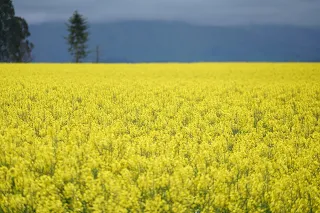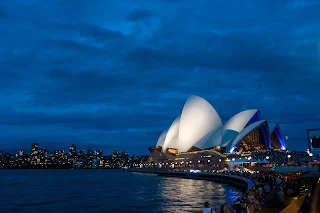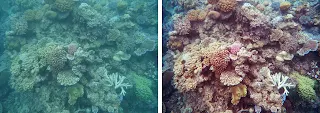I just returned from a major trip to Australia and New Zealand. Lots of photos and stories. No time for a travelogue-style blog post. I'll have to contain all of what I have to say to captions. Here goes...
(As with all blog posts, click on any image to make it larger. And sharper.)
 |
| Rape plants, from which we get canola oil. Very colorful! |
 |
| A stock shot in Wellington. Everyone who's ever visited has this exact same shot. Other than sheer megapixels mine's not any better. Sometimes you have to just cover your bases. |
 |
| New Zealand is beautiful and covered in green. Sheep are as plentiful as mass shootings in the U.S. |
 |
| You can do anything in Queenstown, from parasailing to bungee jumping. |
 |
| The top of "The Remarkables" mountain ranges. |
 |
| [Yawn] More natural beauty. |
 |
| [Yawn] Another picture-perfect landscape. |
 |
| The ocean water is freezing... however a part of Hot Water Beach sits atop a geothermal vent. Bring a shovel and dig in the right place and hot water fills the hole. Instant spa! |
 |
| Token shot of the Sydney Harbor Bridge. A blurred ferry was used to try to make it a little more interesting. |
 |
| Cockatoos in a tree. A flash helped make them stand out. |
 |
| Inukshuk heaven. (There were thousands of these in the one area... I wasn't able to get one shot which showed the enormity. But this isn't too bad.) |
 |
| Another beautiful coast on the Great Ocean Road |
 |
| All my life I had wondered where mint-flavored marshmallows were grown... |
 |
| A pier in Lorne |
 |
| Trick of Trade - signage usually contains highly directional reflective coating. If your subject doesn't "pop" then even using a small flash can illuminate it quite strongly. Now I can license this. |
 |
| A wild King Parrot. Not in a zoo. :-) |
 |
| Snorkeling on the Great Barrier Reef and petting a Maori Wrasse. |
 |
| Participants in the seminar in Melbourne... two other seminars also took place in Sydney, and near Auckland. Everyone had a great time! |
More about this trip (including stories and what equipment I used, since everyone always seems to want to know that) can be found in the upcoming issue of f2 Cameracraft.
In the Pipeline
The A7r II ebook is out! I'm hoping to have the .epub and .mobi conversions done before Christmas. If you purchased the ebook via my website, you'll be automatically notified of the new versions when they become available.
The Spanish translation of the A6000 Ebook will be out in the same time frame. Email me if you'd like to know when it becomes available.
Great Gifts: I would be derelict in my duties if I didn't point out that both f2 Cameracraft magazine and the streaming version of The Friedman Archives Seminars make great holiday gifts for the photographically inclined folks in your life! :-)
The Published Photographer's Perpetual Nightmare
Let's go back to that photo of the Ice Bar for just a second. It took a long time to get that shot, for as impressive as the frozen room was, the ever-changing light just wasn't great for the camera.
 |
| No flash |
 |
| Flash (held by an assistant) but auto white balance |
 |
| Flash and white balance set to "Daylight" |
 |
| Once I nailed the light, I waited about 2 minutes for the ambient light to change color to this (great color contrast can draw your eye to the shot). |
Problem over, right? Nope. If you're going to have the image printed in a magazine (as this will be in the next issue of f2 Cameracraft), you have to take into account that if you convert this image to CMYK mode (the four colors used in offset printing) the image will look NOTHING like it did on the screen! The screen creates its colors using additive light (combining different amounts of red, green, and blue), whereas the printing press by necessity uses the opposite of these colors (cyan, magenta, yellow, and then black for extra contrast). Not all methods can represent all colors, and this picture, as luck would have it, has lots of colors that just fall "out of gamut":
That beautiful blue which makes the shot is all muddy!!! Yuk! Most print houses would just print the version above, and the client would then be furious at the bad repro. David Kilpatrick, publisher of f2 Cameracraft and king of all things printing, cares about the output so much that he spent 10 minutes tweaking the image in Photoshop in CMYK mode (something most print houses would simply never do) to make it look close to the original. Here's what he did, in his own words:
"To get the big shifts needed in each colour channel, I use the ‘Camera Raw’ filter option first for processing the opened JPEG and changing the camera calibration - I had to make the blue a lot less purple and the reds more orange less magenta. Highlights and contrast needed adjustment too. I created an adjustment brush (in Camera Raw filter) which lifted the highlights and deepened shadows and also added exposure, and painted this over the ice without going over the bar attendant, until I felt that the ICEBAR logo and the texture of the ice was going to reproduce well. I worked on the image in RGB, but used the ‘Proof Colors’ options in Photoshop to see how it would print in CMYK, and returned to this between adjustments.
I find the Camera Raw filter very useful for working on JPEGs and prefer it to using layers. It’s actually the same as using some very complex layers, but much faster. It’s even better if you start with a 16-bit JPEG or TIFF, as these are nearly as good as an original raw file."
Below is the result which prints the same way it appears on screen:
THIS is why professionals care about color matching between screen and print! Had David not corrected this I would have been a bit miffed.
Footnote: In case you'd like to visit the Ice Bar yourself, their address is:
Minus 5 degrees Ice Bar
88 Beach St.
Steamer Wharf
Queenstown 9300 NZ
That's it! Next month I'm going to have some kickstarter ideas for you. :-)
Yours Truly, Gary Friedman














I hope this means you enjoyed your time in NZ Gary....Rob
ReplyDeleteActually, we enjoyed it so much that we plan to return for a much longer period in the future! GF
DeleteAs usual your tricks and advice are extremely helpful, Thanks for sharing your Pictures +1
ReplyDeleteGood humor: "New Zealand is beautiful and covered in green. Sheep are as plentiful as mass shootings in the U.S. " (Sad, but true.)
ReplyDeleteWhat humor? :-)
DeleteBecause I'm cheap, is there something similar to "Camera Raw" and "Proof Color" in GIMP? This shot for example was a nightmare to print. https://500px.com/photo/129188501/%E5%A4%9C%E8%AA%AD-by-firas-kra%C3%AFem
ReplyDeleteI've never used the GIMP, so I can't comment intelligently. Anyone?
DeleteYou need a converter, such as UFRAW, to manipulate raw files using GIMP. I haven't tried it but this link should help:
ReplyDeletehttp://howtogimp.com/raw-photos-with-gimp/
Best of luck.
Geoff Cox
Thanks for the lovely reminder of my 5 weeks in Queenstown where my son lives. My wife and I both did the parasailing from Bob's peak as per your photo. A thrilling experience.
ReplyDeleteWe also visits the Barrier reef previously but found it to be incredibly spectacular and it's top of our list for another visit.
Hi, Robert. How long ago were you there? People we spoke to there said it has been "in a bit of a decline".
DeleteHi Gary.
DeleteOur visit to the Barrier Reef was in 2002 and we stayed on Lady Elliot Island at the very south of the reef. The reef was just a few yards from the door of out chalet.. We could snorkel twice a day over the outer edge of the reef where my wife swam for a few minutes close beside a manta ray. It was the dazzling colours of the fish that surprised us. I've never seen a photograph do justice to the spectacle we saw.
We visited Queenstown in March and April this year and previously in 2004. It certainly has changed and grown with urban sprawl in that interval. However the area around, especially as you leave the paved roads at the far end of the lake, is still so beautifully unspoiled. The town is also much busier with tourists.
We did manage to see three seasons, warm summer ( by my Irish standards ) a few days of snow at town level and then autumnal (fall) colours to finish with.
In spite of the fact that this is the most distant spot on the planet from home, 'We'll be back'
Robert
Hello,
ReplyDeleteThank you very much for sharing your beautiful pictures. I was wondering what it takes to produce that beautiful cobalt blue in your night shots. Especially this one:
http://3.bp.blogspot.com/-91H-Vf1s1sU/VlwaYRbk3XI/AAAAAAABMQo/mCrtLdEgk2A/s1600/DSC06855%2BLR5.jpg
Does the time of the day matter, possibley at dawn when the sky is just about to get lighter? Or is it done in post process? Possibly a filter?
P.S. I've recently finished your Sony A6000 book and it completely changed my attitude towards photography. Very well written in easy to understand manner. I'm so happy I read it!
Hi, Mika. That image you refer to was pretty much straight out of the camera (I just cropped it a little bit). No filters nor any color changes in Photoshop. This was taken at dusk, but dawn would look just as good. All digital cameras are hyper-sensitive to this color for some reason, so the blue looks more spectacular than it does to your eyes.
Delete(Oh, and glad you like the book!)
DeleteThank you very much for your reply and info, Gary!
DeleteGood to know where mint-flavored marshmallows come from. Did you know white marshmallows are grown in Norway?
ReplyDeleteCanada too! :-)
Delete"You have been around", great to see the places you visited. So similar to what I experienced in 2012 and 2013. I have to go there again with my Sony A7.
ReplyDeleteI sat mesmerized as if I were reading a novel getting deeper and deeper into the plot. I enjoyed this post so much, I am reading again! Brilliant. Bravo! Thank YOU!
ReplyDeleteThank YOU, Sheila! If you want to read the rest of the story, the next issue of f2 Cameracraft will have much more detail! :-)
DeleteGary
ReplyDeleteIt has been interesting reading this blog.
It is a pity we had so much rain in Sydney while you were here,you did not get to see our city at it's best.
I thoroughly enjoyed your seminar and have already put some of your lessons into practice, many thank for two very enjoyable days.
Hi Gary,
ReplyDeleteexcellent post put together and agree with Jim the weather wasn't the kindest but a wealth of information came from the seminar.
Anyone that attended now has a nice new bag of tricks to put towards their photography for us all to enjoy what we love doing.
I discovered Gary on one of the Sony Facebook communities just before I got frustrated with all the a7r2 settings and idiosychrosies.
ReplyDeleteHi,
ReplyDeleteAbout a year ago I bought your guide to the Sony A7II. Unfortunately my Surface crashed and I can't get the guide off. How can I get a new copy from you to my computer?
thanks, Phil
Send me an email. GF
Delete